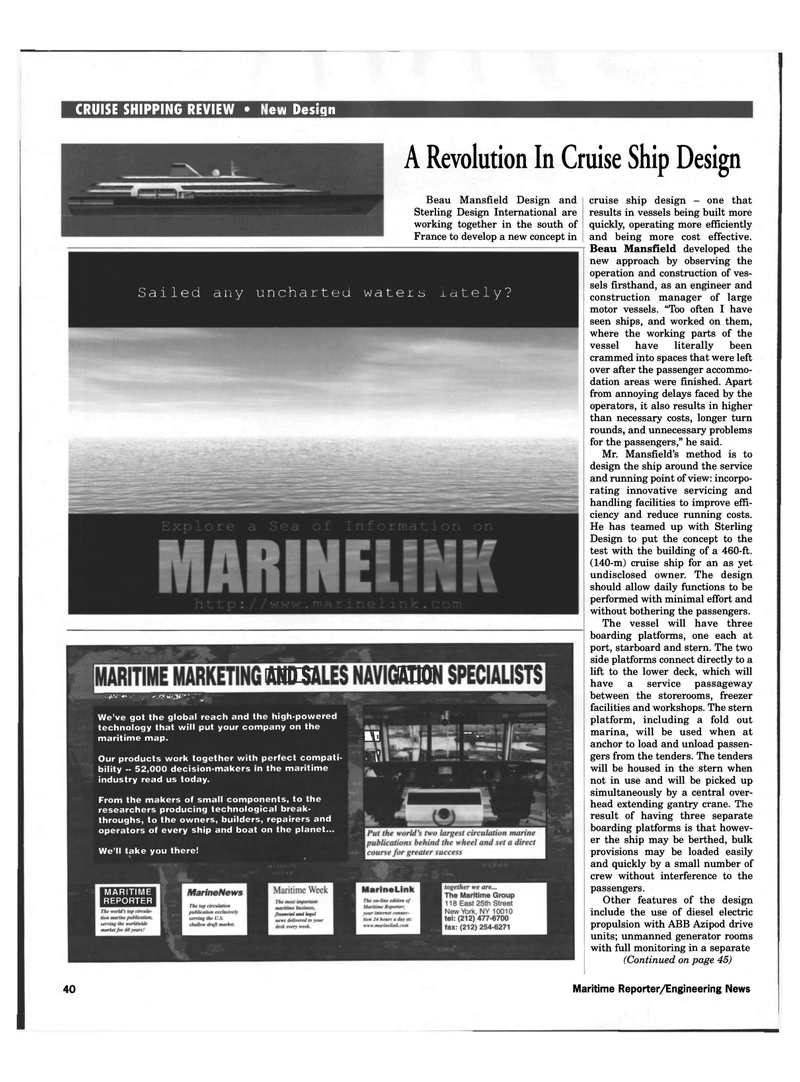
Page 43: of Maritime Reporter Magazine (February 1999)
Read this page in Pdf, Flash or Html5 edition of February 1999 Maritime Reporter Magazine
CRUISE SHIPPING REVIEW • Interior Design
A Revolution In Cruise Ship Design
Beau Mansfield Design and
Sterling Design International are working together in the south of
France to develop a new concept in
Sailed any uncharted waters lately? •BHqpvjnnE^ b ikT h\m
We've got the global reach and the high-powered technology that will put your company on the maritime map. 11
Our products work together with perfect compati- . A' bility -- 52,000 decision-makers in the maritime industry read us today.
From the makers of small components, to the researchers producing technological break- throughs, to the owners, builders, repairers and operators of every ship and boat on the planet...
We'll take you there!
MARITIME
REPORTER - ... cruise ship design - one that results in vessels being built more quickly, operating more efficiently and being more cost effective.
Beau Mansfield developed the new approach by observing the operation and construction of ves- sels firsthand, as an engineer and construction manager of large motor vessels. "Too often I have seen ships, and worked on them, where the working parts of the vessel have literally been crammed into spaces that were left over after the passenger accommo- dation areas were finished. Apart from annoying delays faced by the operators, it also results in higher than necessary costs, longer turn rounds, and unnecessary problems for the passengers," he said.
Mr. Mansfield's method is to design the ship around the service and running point of view: incorpo- rating innovative servicing and handling facilities to improve effi- ciency and reduce running costs.
He has teamed up with Sterling
Design to put the concept to the test with the building of a 460-ft. (140-m) cruise ship for an as yet undisclosed owner. The design should allow daily functions to be performed with minimal effort and without bothering the passengers.
The vessel will have three boarding platforms, one each at port, starboard and stern. The two side platforms connect directly to a lift to the lower deck, which will have a service passageway between the storerooms, freezer facilities and workshops. The stern platform, including a fold out marina, will be used when at anchor to load and unload passen- gers from the tenders. The tenders will be housed in the stern when not in use and will be picked up simultaneously by a central over- head extending gantry crane. The result of having three separate boarding platforms is that howev- er the ship may be berthed, bulk provisions may be loaded easily and quickly by a small number of crew without interference to the passengers.
Other features of the design include the use of diesel electric propulsion with ABB Azipod drive units; unmanned generator rooms with full monitoring in a separate (Continued on page 45) 40 Maritime Reporter/Engineering News

 42
42

 44
44
